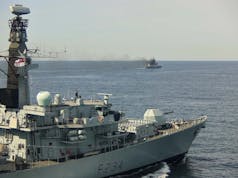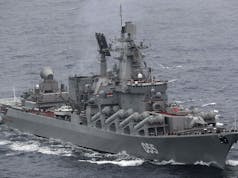Tanker RFA Tideforce rendezvoused with Canadian and Portuguese warships in the narrows between Denmark and the Scandinavian peninsula to support ongoing NATO operations.
HMCS Toronto and NRP Corte Real are attached to the alliance’s Standing Maritime Group 1, which patrols the waters of northern Europe from the Baltic to Atlantic carrying out collective training and championing NATO’s work and peacekeeping mission.
According to the Royal Navy in a statement:
“Fresh from working with HMS Mersey in these same waters, the NATO duo stationed astern of the 39,000-tonne Royal Fleet Auxiliary in near-perfect conditions in the Skagerrak to take on their black gold from Tideforce’s cavernous tanks. The tanker called the warships forward and then conducted the replenishment at sea largely by visual signaling such as flags and Morse code by lamp as the sun descended.”
“It was a privilege for RFA Tideforce to be able to support Maritime Group 1,” said Captain Simon Herbert, the tanker’s commanding officer.
“Both ships were able to benefit from our state-of-the-art replenishment at sea capabilities and remain on their tasking conducting NATO missions as part of the NATO Maritime Response Force. The replenishments clearly highlighted the integrated and flexible capability of the newest of the RFA Tide-class tankers.”














These tankers were a bargain. You couldn’t even buy 1 type 26 frigate for the cost of 4 of the tide tankers! 550 million for 4, but then fitting out With the electronics ect in the UK bumped that up a bit.
Not to mention the faulty wiring and firefighting system that all had to be fixed. No wonder the MOD have twice refused to release details of this contract even after two requests under the FOI act.
Things had to be fixed, as is always the case no matter what you are building. But at the end of the day these ships were bargains.
Doesn’t sound like a bargain to me, considering a commercial oil rig would cost in the millions not hundreds. Ok these are a little more complex as they can refuse at sea, but hundreds of million more seems unlikely as they are not build to warship spec.
550 million quid with no tax back means between 800 to 900 million quid plus the UK protected bit means around one billion pounds. The worst deal in UK history and you kill your own industry potential for it. Mugs!
I think £550M with no tax back is still £550M, if I’m not mistaken…? Unless you mean any taxes we may have been obliged to pay getting them from Korea to here, but I’d expect that to be covered within the contract price- it normally is.
Even if you’re right and it was £1B for 4 vessels, that’s £250M a pop for critical connectors and enablers that set us apart from most navies in NATO when it comes to the real unsung hero of logistics. I don’t think that’s at all bad.
Where you and I both agree: They should have been built in the UK, supporting British industry.
USNS John Lewis: a little larger, but the contract sum is $649 million for one ship. On that basis, the Tide class were definitely a bargain………
Never knowingly under sold ! ?
Lovely 🙂
Point me towards the UK yard that could have delivered four tankers at the price and within the time-frame that the MOD had specified. People here forget that no UK yard bid for this contract. The UK lost it’s world leading ship building industry decades ago due to a host of issues. The failure to consolidate leading to a large number of yards competing against each other. The majority of yards being in estuary rivers seriously hampering the efficiency of production. Failure to modernise after WWII exacerbated by a glut of surplus war built commercial shipping. Yard owners who saw more profit in selling land for residential development than modernisation and expansion. Failure to capitalise on the semi-complex Cruise Ship boom. The fact that no EU yard let alone a UK yard is ever going to be able to build a bulk carrier or tanker at a price that the market is prepared to pay for.
The simple unpalatable truth (to paraphrase the very knowledgeable Not-A-Boffin) is that to build ships efficiently you need modern integrated facilities – which don’t currently exist, not a collection of disparate yards producing sub-assemblies to be erected around the country.
Howling at the moon about how these ships should have been built in the UK fails to acknowledge the reasons why they were not!
No UK yard bid for the contract because they were not welcome.
Utter nonsense Darren! What do you mean ‘Not Welcome’?
No UK yard bid because they were already busy with work for the QE class and the delivery schedule and price point expected by the MOD for the project was not achievable or profitable.
Great looking vessels
Like to see these commercial ships doing a little bit more commercial shipping.
They would be hopelessly uneconomic as commercial tankers: relatively small oil capacity with large engines designed for a top speed of some 26 knots.
I was going to say… they’re not really “commerical ships.”
No shipping firm that operates Tankers would buy a UK built tanker, it would be commercially insane! No UK yard has a hope of building one at a price point that the industry would be prepared to accept!
No if I was a shipping operator I would be placing my order in Vietnam like every other company in that sector is at the moment!
http://sbic.com.vn/default.aspx/?lang=2
I’m obviously pro Royal Navy and pro British ship building but these where a bargain! Great looking boats too!